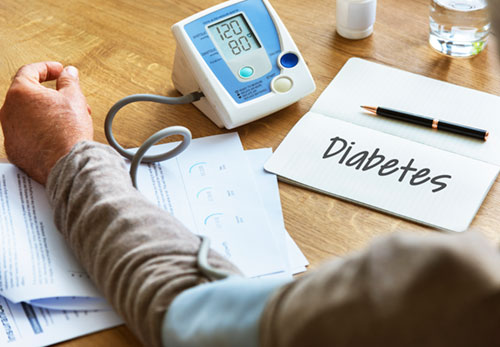Introduction
Diabetes mellitus which was initially considered a risk factor for cardiovascular and cerebrovascular disease has now been given a special status of a separate disease entity -“equivalent disease”.
The trajectory from just a risk factor to an equivalent disease is contributed equally by increasing prevalence and recognition of “obesity-adiposopathy-metabolic syndrome-insulin resistance-diabetes mellitus” phenomena and increasing recognition of the pattern of coronary artery disease in such patients.

Pathophysiology of Vascular Disease in Diabetes Mellitus
The common incriminating factor in micro- and macro-vascular complications of diabetes mellitus is AGE – advanced glycosylation end products, the target cell being the endothelial cell and its basement membrane.
Endothelial cell damage in micro-vessels like capillaries and arterioles results in micro-vascular complications like neuropathy, nephropathy and retinopathy.
Endothelial cell damage in major arteries results in complications including cardiovascular disease, cerebrovascular disease and peripheral vascular disease.
Definition of Pre-Diabetes and Diabetes
| Normal | Pre-Diabetes | Diabetes Mellitus | |
| FBS | <100 | 100-125 | >126 |
| PPBS | <140 | 140-199 | >200 |
| HbA1c | <5.7 | 5.7-6.4 | >6.4 |
How Are Patients with Diabetes and Coronary Artery Disease Different from Non-Diabetic Patients?
- More atypical nature of chest pain
- Silent ischemia or myocardial infarction
- Presentation with heart failure
- Multi-vessel coronary artery disease
- Severe or critical coronary artery disease
- Need for CABG more than non-diabetic patients
- Sub-optimal graft flow
- Micro-vascular coronary artery disease also called as cardiac syndrome X or angina with non-obstructive coronary artery disease
What Are the Major Treatment Goals in Diabetic Population in Prevention of Coronary Artery Disease?
There are three main goals:
- Optimal glycemic control
- Control of other risk factors like hypertension
- Control of dyslipidemia
Optimal Glycemic Control
This is achieved by a multipronged approach:
- Regular dietary restriction of added sugars, excessive carbohydrates and saturated fats.
- Regular physical activity is described as moderate-intensity physical activity like walking, cycling, jogging or swimming for at least 20 minutes every day for five days a week.
- Drug therapy or insulin therapy as indicated.
Control of Hypertension
- Target BP being intense control of 130/85 mm of Hg with any conventional anti-hypertensive medication like ACE inhibitors, ARB, beta blockers, CCB and thiazide diuretics.
- No single drug is superior to the other.
- Keeping in mind the hyper-glycemic effect of beta-blockers and thiazide diuretics.
Lipid Management Goals:
| Without CVD | With CVD | |
| LDL | <100 | <70 |
| Non-LDL | <130 | <100 |
Aggressive management of high LDL levels with statins.
If goals are unachievable with a single drug regimen, additional ezetimibe or bile acid sequestrants or nicotinic acid is indicated.
In severe refractory patients, treatment with PCS K9 inhibitors like alirokumab or evolocumab is indicated.
Atherothrombotic Prevention
Low-dose aspirin for men more than 50 years of age and women more than 60 years of age with diabetes and an additional risk factor for CVD is indicated.
Not undermining the need for early detection of coronary artery disease in diabetes keeps the index of suspicion higher and the threshold for testing with an exercise test or a myocardial perfusion test lower for a diabetic patient.

Dr. S. Booma
Associate Consultant, Department of Cardiology,
Kauvery Hospital Chennai
